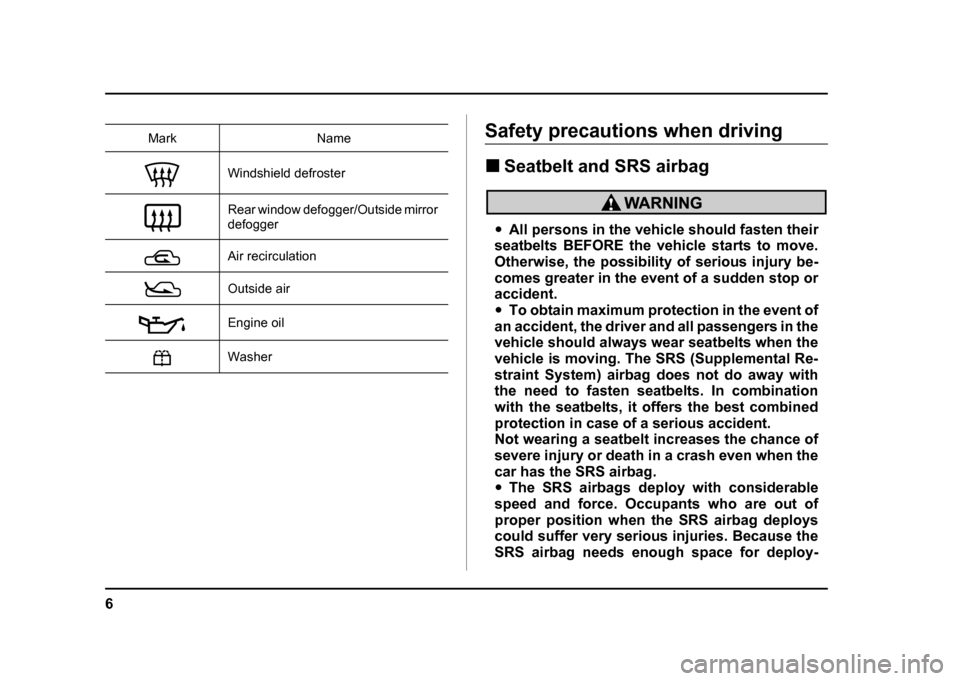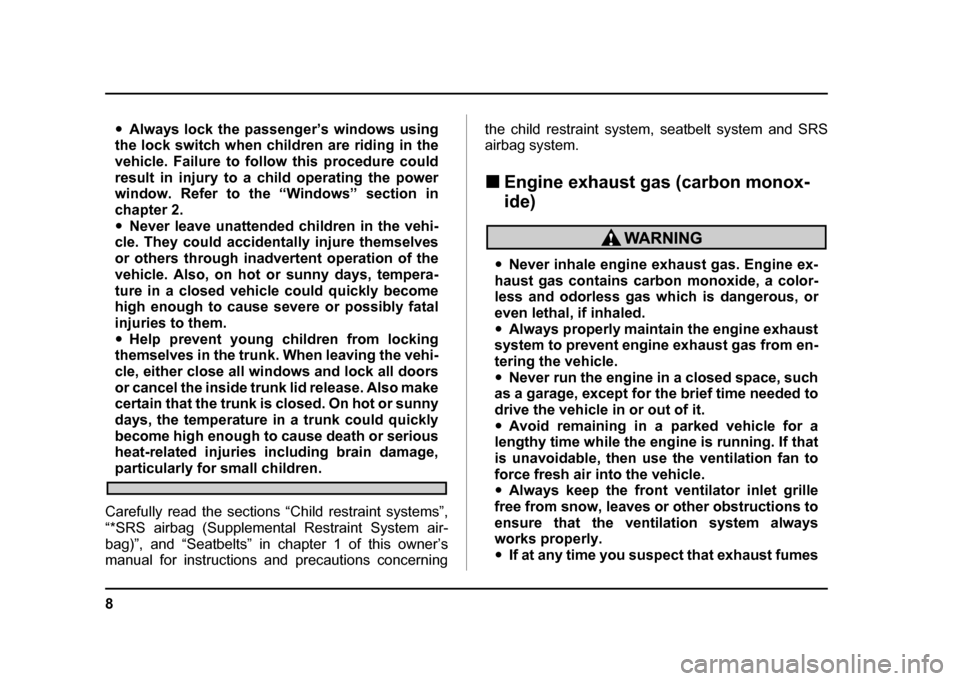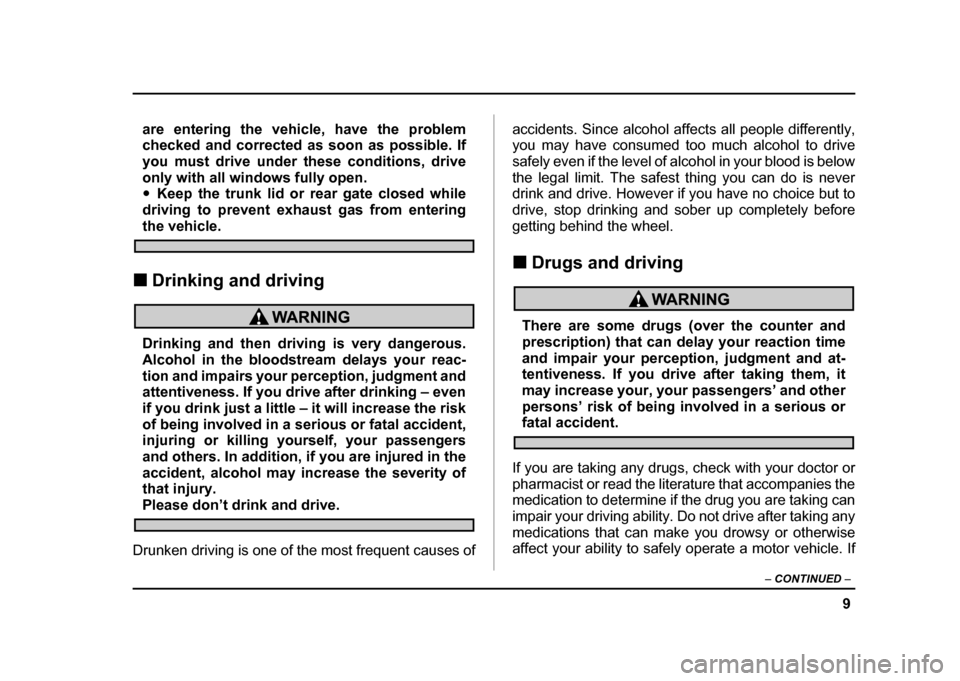Page 5 of 491

2
How to use this owner’s manual !Using your Owner’s manual
Before you operate your vehicle, carefully read this
manual. To protect yourself and extend the service life
of your vehicle, follow the instructions in this manual.
Failure to observe these instructions may result in se-
rious injury and damage to your vehicle.
This manual is composed of fourteen chapters. Each
chapter begins with a brief table of contents, so you
can usually tell at a glance if that chapter contains the
information you want.
Chapter 1: Seat, seatbelt and SRS airbags
This chapter informs you how to use the seat and seat-
belt and contains precautions for the SRS airbags.
Chapter 2: Keys and doors
This chapter informs you how to operate the keys,
locks and windows.
Chapter 3: Instruments and controls
This chapter informs you about the operation of instru-
ment panel indicators and how to use the instruments
and other switches.
Chapter 4: Climate Control
This chapter informs you how to operate the climate
control.
Chapter 5: Audio This chapter informs you how to operate your audio system.
Chapter 6: Interior equipment
This chapter informs you how to operate interior
equipment.
Chapter 7: Starting and operating
This chapter informs you how to start and operate your SUBARU.
Chapter 8: Driving tips
This chapter informs you how to drive your SUBARU
in various conditions and explains some safety tips on
driving.
Chapter 9: In case of emergency
This chapter informs you what to do if you have a prob-
lem while driving, such as a flat tire or engine over-
heating.
Chapter 10: Appearance care
This chapter informs you how to keep your SUBARU
looking good.
Chapter 11: Maintenance and service
This chapter informs you when you need to take your
SUBARU to the dealer for scheduled maintenance
and informs you how to keep your SUBARU running
properly.
Chapter 12: Specifications
This chapter informs you about dimension and capac-
ities of your SUBARU.
Page 7 of 491
4
ual. This symbol means “Do not”, “Do not do this”, or
“Do not let this happen”, depending upon the context.Vehicle symbols
There are some of the symbols you may see on your vehicle.Mark Name CAUTION
Power door lock and unlock
Passenger’s windows lock and un-
lock Fuel
Front fog lights
Parking lights
Hazard warning flasher
Cigarette lighter
Page 8 of 491
5
–
CONTINUED –
Engine hood
Trunk lid (Sedan)
Seat heater
Child restraint top tether anchorages
Child restraint lower anchorages
Horn
Windshield wiper deicer
Wiper intermittent
Windshield wiper and washer
Mark NameRear window wiper and washer Lights
Parking lights, tail lights, license plate
light and instrument panel illumination
Head lights
Illumination brightness
Fan speed
Instrument panel outlets
Instrument panel outlets and foot out- lets
Foot outlets
Windshield defroster and foot outlets
Mark Name
Page 9 of 491

6
Safety precautions when driving !Seatbelt and SRS airbag
"All persons in the vehicle should fasten their
seatbelts BEFORE the vehicle starts to move.
Otherwise, the possibility of serious injury be-
comes greater in the event of a sudden stop or
accident. " To obtain maximum protection in the event of
an accident, the driver and all passengers in the
vehicle should always wear seatbelts when the
vehicle is moving. The SRS (Supplemental Re-
straint System) airbag does not do away with
the need to fasten seatbelts. In combination
with the seatbelts, it offers the best combined
protection in case of a serious accident.
Not wearing a seatbelt increases the chance of
severe injury or death in a crash even when the
car has the SRS airbag. " The SRS airbags deploy with considerable
speed and force. Occupants who are out of
proper position when the SRS airbag deploys
could suffer very serious injuries. Because the
SRS airbag needs enough space for deploy-
Windshield defroster
Rear window defogger/Outside mirror
defogger
Air recirculation
Outside air
Engine oilWasher
Mark Name
Page 11 of 491

8
"Always lock the passenger’s windows using
the lock switch when children are riding in the
vehicle. Failure to follow this procedure could
result in injury to a child operating the power
window. Refer to the “Windows” section in
chapter 2." Never leave unattended children in the vehi-
cle. They could accidentally injure themselves
or others through inadvertent operation of the
vehicle. Also, on hot or sunny days, tempera-
ture in a closed vehicle could quickly become
high enough to cause severe or possibly fatal
injuries to them." Help prevent young children from locking
themselves in the trunk. When leaving the vehi-
cle, either close all windows and lock all doors
or cancel the inside trunk lid release. Also make
certain that the trunk is closed. On hot or sunny
days, the temperature in a trunk could quickly
become high enough to cause death or serious
heat-related injuries including brain damage,
particularly for small children.
Carefully read the sections “Child restraint systems”,
“*SRS airbag (Supplemental Restraint System air-
bag)”, and “Seatbelts” in chapter 1 of this owner’s
manual for instructions and precautions concerning the child restraint system, seatbelt system and SRS airbag system. !
Engine exhaust gas (carbon monox- ide)
"Never inhale engine exhaust gas. Engine ex-
haust gas contains carbon monoxide, a color-
less and odorless gas which is dangerous, or
even lethal, if inhaled." Always properly maintain the engine exhaust
system to prevent engine exhaust gas from en-
tering the vehicle." Never run the engine in a closed space, such
as a garage, except for the brief time needed to
drive the vehicle in or out of it." Avoid remaining in a parked vehicle for a
lengthy time while the engine is running. If that
is unavoidable, then use the ventilation fan to
force fresh air into the vehicle. " Always keep the front ventilator inlet grille
free from snow, leaves or other obstructions to
ensure that the ventilation system always
works properly. " If at any time you suspect that exhaust fumes
Page 12 of 491

9
–
CONTINUED –
are entering the vehicle, have the problem
checked and corrected as soon as possible. If
you must drive under these conditions, drive
only with all windows fully open. "Keep the trunk lid or rear gate closed while
driving to prevent exhaust gas from entering
the vehicle.
! Drinking and driving
Drinking and then driving is very dangerous.
Alcohol in the bloodstream delays your reac-
tion and impairs your perception, judgment and
attentiveness. If you drive after drinking – even
if you drink just a little – it will increase the risk
of being involved in a serious or fatal accident,
injuring or killing yourself, your passengers
and others. In addition, if you are injured in the
accident, alcohol may increase the severity of
that injury.
Please don’t drink and drive.
Drunken driving is one of the most frequent causes of accidents. Since alcohol affects all people differently,
you may have consumed too much alcohol to drive
safely even if the level of alcohol in your blood is below
the legal limit. The safest thing you can do is never
drink and drive. However if you have no choice but to
drive, stop drinking and sober up completely before
getting behind the wheel. !
Drugs and driving
There are some drugs (over the counter and
prescription) that can delay your reaction time
and impair your perception, judgment and at-
tentiveness. If you drive after taking them, it
may increase your, your passengers’ and other
persons’ risk of being involved in a serious or
fatal accident.
If you are taking any drugs, check with your doctor or
pharmacist or read the literature that accompanies the
medication to determine if the drug you are taking can
impair your driving ability. Do not drive after taking any
medications that can make you drowsy or otherwise
affect your ability to safely operate a motor vehicle. If
Page 18 of 491
15
–
CONTINUED –
12
34 4 623
4
45 17
UGF502BB
1) Rear window defogger switch
(page 3-40)
2) Fuel filler lid and cap (page 7-4)
3) Child safety locks (page 2-21)
4) Tie-down/Towing hook (page 9- 18)
5) Trunk lid (page 2-25)
6) Rear gate (page 2-29)
7) Roof rail (page 8-21)
Page 21 of 491
18
!
Instrument panel
12345 6
7
8
9
11
12
13
14
15
16 10
UGF056BB
1) Door locks (page 2-3)
2) Light control lever (page 3-29)
3) Combination meter (page 3-15)
4) Wiper control lever (page 3-35)
5) Hazard warning flasher switch
(page 3-6)
6) Audio (page 5-1)
7) Gear shift lever (MT) (page 7- 15)/Selector lever (AT) (page 7-
21)
8) Outside mirror switch (page 3-
48)
9) Climate control (page 4-1)
10) Cruise control (page 7-37)
11) Horn (page 3-50)
12) SRS airbag (page 1-52)
13) Tilt steering (page 3-49)
14) Fuse box (page 11-60)
15) Hood lock release (page 11-5)
16) Power window (page 2-22)